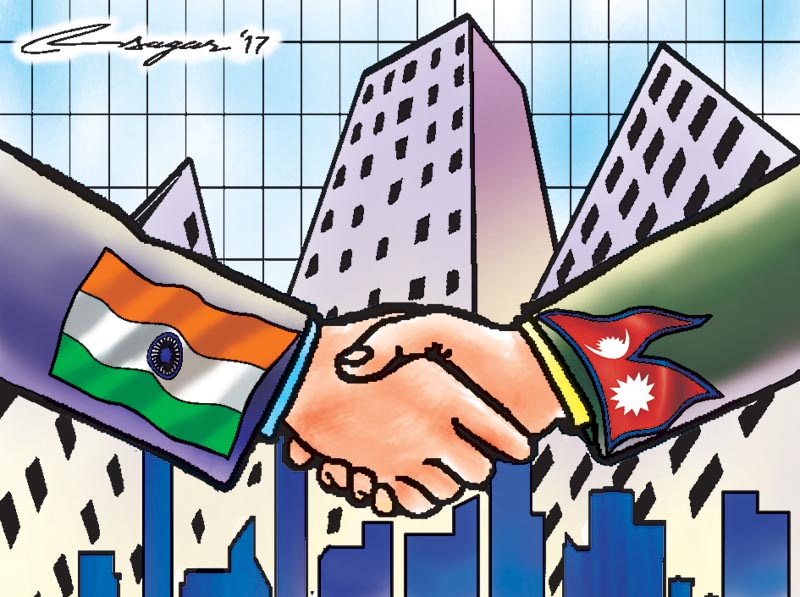Growing trade deficit: Hydro solutions
The primary need of the country lies in increasing the supply side capacity of the goods and services by producing them at the desired level of quality and quantity within reasonable cost
India remains the single largest trading partner of Nepal always in the economic history of Nepal. Before 1950, the trade balance was in favor of Nepal which is mainly attributed to the closed political and economic regimes espoused by the Rana prime ministers. The overall volume of Nepalese trade at the end of 1949-50 was NRs. 204 million which was minuscule in the context of market opportunities available in India. During those periods, Nepal used to import industrial goods, consumable goods like salt, kerosene, cigarettes etc. while exports consisted of agricultural and forest products, handicraft items, hides and skins and other primary products. Two Nepalese missions, one in Kolkata and another in Patna, were established to facilitate bilateral trade. Meanwhile the Kolkata office also took the coordination function for moving the Nepal bound goods between the port in Kolkata and Kathmandu.
The volume of international trade of Nepal increased immensely after 1970s, propelled by the preferential market access under the Generalized System of Preferences (GSP), and quota for textile and garment under the Agreement of Textile and Clothing, under the auspices of GATT-1947. Export to overseas countries was also facilitated by the separate treaty of transit concluded between the government of Nepal and government of India in 1978. Consequently Nepalese exports took a new height during the 1990s both in India and oversea countries, thanks to the provision made in the bilateral treaty of trade in 1996 allowing duty free access to all products made in Nepal with the control given to Nepalese authorities to decide the status of origin of exportable products. Import of the products and services picked up after the 1990s to meet the aggregate demand fueled by the remittance by the large number of migrant workers in the Gulf countries and Malaysia.
Nepal’s deficit in trade of merchandized goods has been increasing at an alarming rate over the last one decade. In 2005-06, Nepalese export supported 33 percent of the total import while the rapid erosion in the export capacity resulted in a reduction of this figure to merely 8 percent in 2015-16. As India is a natural trade partner in view of proximity of locations with open and porous borders a lot of local trade goes on unrecorded propelling the intensity of trade imbalances.
Major products contributing to the rising trade deficit are petroleum products, vehicles and their parts. Nepal imports all kinds of petroleum products from India, and more than 90 percent of the motor vehicles and their parts are also imported from India. According to the TEPC data, these two products comprises 20 percent of the total import in 2015-16. The volume of official import of petroleum products was comparatively low during that particular year due to border obstructions. In a normal period, import of petroleum products alone accounts for more than 15 percent of the total import. Thus, reducing trade deficit would require appropriate strategies to manage the import of these products.
Developing hydro-projects for supply of power for industries, transport and household and irrigation water for the large tract of land in Terai would be an alternative to deal with the burgeoning issues of trade deficit. The availability of electric power at the household level at an affordable price will drastically reduce the consumption of LPG in the kitchen and also the use of diesel being used by industries to support their production. This will have cascading effects on the import of diesel generator sets and batteries used for power inverters. Development of a mass transit system would be the means of reducing the import of transport vehicles including the POL products.
With the development of modern transport and communication infrastructures, countries in the contiguous locations are more enticed to the notion of fragmentation of production and integration of markets. But, there are only a few areas where Nepalese and Indian industries are integrated in the vertical value chain. It is important for the two countries to make facilitative arrangements in the bilateral treaty in order to enable the industries in the two countries to work together to supplement the production. This may require provisions of long term contract, relaxing the rules of origin criteria and simplification of customs procedures at the borders.
Supply capacity of goods and services is abysmally low in Nepal. Production and productivity of agriculture and manufacturing sector is less than in other South Asian countries like India, Bangladesh and Sri Lanka. The services sector is marred by the lack of quality services and the appropriate infrastructures. Thus, the primary need lies in increasing the supply side capacity of the goods and services by producing them at the desired level of quality and quantity within reasonable cost. As a landlocked country, focus should be on developing high value products with specific characteristics that would help capture the big markets available at the doorsteps.
Trade deficit has been a much hyped jargon in Nepalese media and economic discourse. Many government officials, academia, political and business leaders express their concern over this sorry state of affairs but not much is happening to address the issues on the ground. Time has come to act rather than simply paying lip service to the problems that are reverberating at public functions and being highlighted in the media.
Ojha is a former secretary of the Government of Nepal






